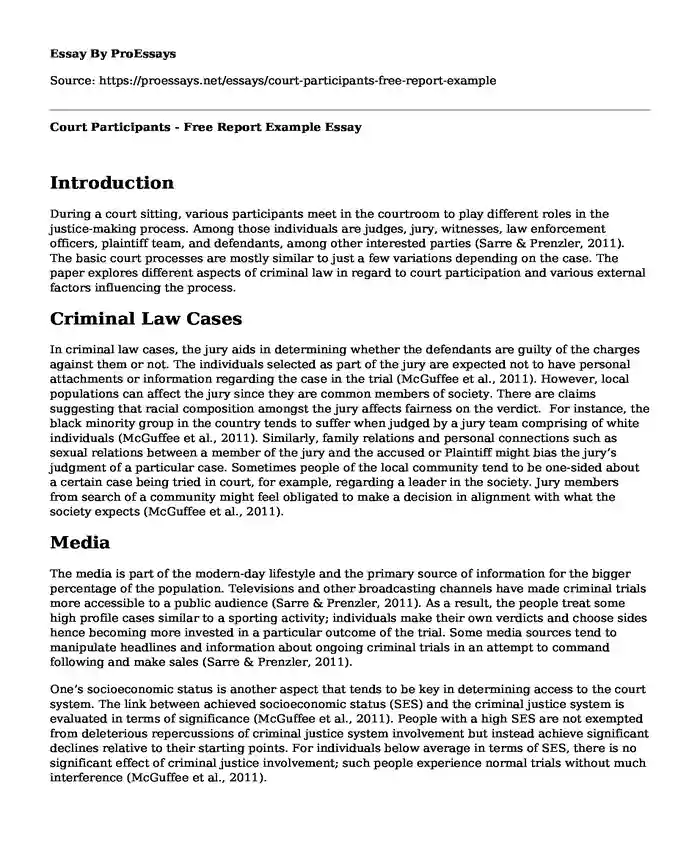Introduction
During a court sitting, various participants meet in the courtroom to play different roles in the justice-making process. Among those individuals are judges, jury, witnesses, law enforcement officers, plaintiff team, and defendants, among other interested parties (Sarre & Prenzler, 2011). The basic court processes are mostly similar to just a few variations depending on the case. The paper explores different aspects of criminal law in regard to court participation and various external factors influencing the process.
Criminal Law Cases
In criminal law cases, the jury aids in determining whether the defendants are guilty of the charges against them or not. The individuals selected as part of the jury are expected not to have personal attachments or information regarding the case in the trial (McGuffee et al., 2011). However, local populations can affect the jury since they are common members of society. There are claims suggesting that racial composition amongst the jury affects fairness on the verdict. For instance, the black minority group in the country tends to suffer when judged by a jury team comprising of white individuals (McGuffee et al., 2011). Similarly, family relations and personal connections such as sexual relations between a member of the jury and the accused or Plaintiff might bias the jury’s judgment of a particular case. Sometimes people of the local community tend to be one-sided about a certain case being tried in court, for example, regarding a leader in the society. Jury members from search of a community might feel obligated to make a decision in alignment with what the society expects (McGuffee et al., 2011).
Media
The media is part of the modern-day lifestyle and the primary source of information for the bigger percentage of the population. Televisions and other broadcasting channels have made criminal trials more accessible to a public audience (Sarre & Prenzler, 2011). As a result, the people treat some high profile cases similar to a sporting activity; individuals make their own verdicts and choose sides hence becoming more invested in a particular outcome of the trial. Some media sources tend to manipulate headlines and information about ongoing criminal trials in an attempt to command following and make sales (Sarre & Prenzler, 2011).
One’s socioeconomic status is another aspect that tends to be key in determining access to the court system. The link between achieved socioeconomic status (SES) and the criminal justice system is evaluated in terms of significance (McGuffee et al., 2011). People with a high SES are not exempted from deleterious repercussions of criminal justice system involvement but instead achieve significant declines relative to their starting points. For individuals below average in terms of SES, there is no significant effect of criminal justice involvement; such people experience normal trials without much interference (McGuffee et al., 2011).
Proper Security
Maintaining proper security is vital for the safety of individuals participating in the process, such as judges, lawyers, court employees, and the public. In addition, ensuring security within the courtroom during ongoing criminal trials is vital, especially when individuals are near prisoners. To ensure a high-security level in a criminal trial, there are various aspects considered (Fix et al., 2017). One secure aspect is using layouts that provide separate access points and separation between the plaintiff and the accused. The court should also adhere to procedures that enable the separation of participants in the trial to avoid extreme confrontations. During a criminal justice trial proceeding, it is necessary that a security detail is provided comprising of law enforcement officers and technological security that eliminates and offers a solution for problematic occurrences (Fix et al., 2017). The furniture design should also facilitate the separation and security of participants, while other court facilities should be designed to support safe trial proceedings (Fix et al., 2017).
Conclusion
The cumulative impact on attitude and performance in the criminal justice system is determined various aspects. Factors such as discrimination and criticism during criminal justice procedures indirectly influence the outcome of the trial. Individuals playing various roles in the system should adapt practices balancing the environmental attitude of the court setting. Some aspects, such as the labeling effect discussed above, might pose a significant impact on a trial hence manipulating its outcome. It is vital that every individual plays his or her role efficiently to enhance the effectiveness of the criminal justice system.
References
McGuffee, K., Garland, T. S., & Eigenberg, H. (2011). Is Jury Selection Fair? Perceptions of Race and the Jury Selection Process. Criminal Justice Studies, 20(4), 445–468.
https://doi.org/10.1080/14786010701758245
Sarre, R., & Prenzler, T. (2011). Issues in courtroom security: A key role for the private sector in Australia and New Zealand. Security Journal, 25(1), 25-37.
https://doi.org/10.1057/sj.2011.3
Fix, M., Kingsland, J., & Montgomery, M. (2017). The Complexities of State Court Compliance with U.S. Supreme Court Precedent. Justice System Journal, 38(2), 149-163.
https://doi.org/10.1080/0098261x.2016.1274245.
Cite this page
Court Participants - Free Report Example. (2023, Dec 12). Retrieved from https://proessays.net/essays/court-participants-free-report-example
If you are the original author of this essay and no longer wish to have it published on the ProEssays website, please click below to request its removal:
- How Egyptian Art Characterized Egyptian Civilization Paper Example
- Social Media: How Social Media Can Lead to Addiction, Cyberbullying and Low Self-Esteem
- Film Analysis Essay on "Good Kurds, Bad Kurds: No Friends but the Mountains"
- Fashion and Identity Essay
- The Mixed-up Office Building: Combining Technology, Architecture and Science
- Modern Perennial Garden: Prairie Planting Style - Essay Sample
- Free Essay Sample on 19th Century: Photography







